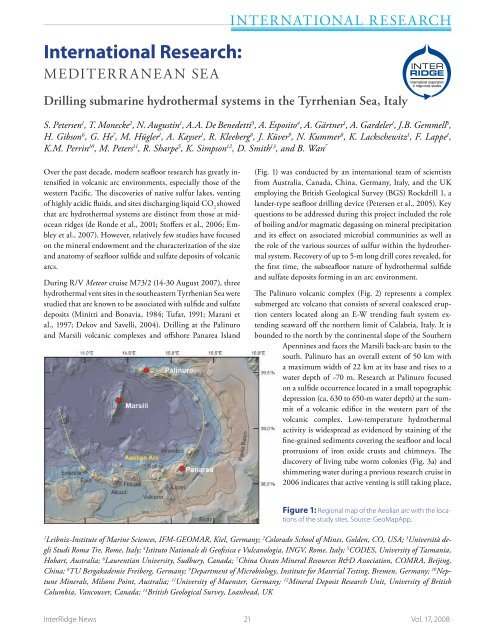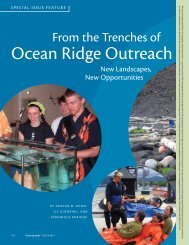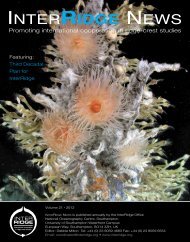Full version, lower resolution, 3.25MB - InterRidge
Full version, lower resolution, 3.25MB - InterRidge
Full version, lower resolution, 3.25MB - InterRidge
Create successful ePaper yourself
Turn your PDF publications into a flip-book with our unique Google optimized e-Paper software.
International Research:<br />
MEditerr anean Sea<br />
International Research<br />
Drilling submarine hydrothermal systems in the Tyrrhenian Sea, Italy<br />
S. Petersen 1 , T. Monecke 2 , N. Augustin 1 , A.A. De Benedetti 3 , A. Esposito 4 , A. Gärtner 1 , A. Gardeler 1 , J.B. Gemmell 5 ,<br />
H. Gibson 6 , G. He 7 , M. Hügler 1 , A. Kayser 1 , R. Kleeberg 8 , J. Küver 9 , N. Kummer 8 , K. Lackschewitz 1 , F. Lappe 1 ,<br />
K.M. Perrin 10 , M. Peters 11 , R. Sharpe 5 , K. Simpson 12 , D. Smith 13 , and B. Wan 7<br />
Over the past decade, modern seafloor research has greatly intensified<br />
in volcanic arc environments, especially those of the<br />
western Pacific. The discoveries of native sulfur lakes, venting<br />
of highly acidic fluids, and sites discharging liquid CO 2<br />
showed<br />
that arc hydrothermal systems are distinct from those at midocean<br />
ridges (de Ronde et al., 2001; Stoffers et al., 2006; Embley<br />
et al., 2007). However, relatively few studies have focused<br />
on the mineral endowment and the characterization of the size<br />
and anatomy of seafloor sulfide and sulfate deposits of volcanic<br />
arcs.<br />
During R/V Meteor cruise M73/2 (14-30 August 2007), three<br />
hydrothermal vent sites in the southeastern Tyrrhenian Sea were<br />
studied that are known to be associated with sulfide and sulfate<br />
deposits (Minitti and Bonavia, 1984; Tufar, 1991; Marani et<br />
al., 1997; Dekov and Savelli, 2004). Drilling at the Palinuro<br />
and Marsili volcanic complexes and offshore Panarea Island<br />
(Fig. 1) was conducted by an international team of scientists<br />
from Australia, Canada, China, Germany, Italy, and the UK<br />
employing the British Geological Survey (BGS) Rockdrill 1, a<br />
lander-type seafloor drilling device (Petersen et al., 2005). Key<br />
questions to be addressed during this project included the role<br />
of boiling and/or magmatic degassing on mineral precipitation<br />
and its effect on associated microbial communities as well as<br />
the role of the various sources of sulfur within the hydrothermal<br />
system. Recovery of up to 5-m long drill cores revealed, for<br />
the first time, the subseafloor nature of hydrothermal sulfide<br />
and sulfate deposits forming in an arc environment.<br />
The Palinuro volcanic complex (Fig. 2) represents a complex<br />
submerged arc volcano that consists of several coalesced eruption<br />
centers located along an E-W trending fault system extending<br />
seaward off the northern limit of Calabria, Italy. It is<br />
bounded to the north by the continental slope of the Southern<br />
Apennines and faces the Marsili back-arc basin to the<br />
south. Palinuro has an overall extent of 50 km with<br />
a maximum width of 22 km at its base and rises to a<br />
water depth of ~70 m. Research at Palinuro focused<br />
on a sulfide occurrence located in a small topographic<br />
depression (ca. 630 to 650-m water depth) at the summit<br />
of a volcanic edifice in the western part of the<br />
volcanic complex. Low-temperature hydrothermal<br />
activity is widespread as evidenced by staining of the<br />
fine-grained sediments covering the seafloor and local<br />
protrusions of iron oxide crusts and chimneys. The<br />
discovery of living tube worm colonies (Fig. 3a) and<br />
shimmering water during a previous research cruise in<br />
2006 indicates that active venting is still taking place,<br />
Figure 1: Regional map of the Aeolian arc with the locations<br />
of the study sites. Source: GeoMapApp.<br />
1<br />
Leibniz-Institute of Marine Sciences, IFM-GEOMAR, Kiel, Germany; 2 Colorado School of Mines, Golden, CO, USA; 3 Università degli<br />
Studi Roma Tre, Rome, Italy; 4 Istituto Nationale di Geofisica e Vulcanologia, INGV, Rome, Italy; 5 CODES, University of Tasmania,<br />
Hobart, Australia; 6 Laurentian University, Sudbury, Canada; 7 China Ocean Mineral Resources R&D Association, COMRA, Beijing,<br />
China; 8 TU Bergakademie Freiberg, Germany; 9 Department of Microbiology, Institute for Material Testing, Bremen, Germany; 10 Neptune<br />
Minerals, Milsons Point, Australia; 11 University of Muenster, Germany; 12 Mineral Deposit Research Unit, University of British<br />
Columbia, Vancouver, Canada; 13 British Geological Survey, Loanhead, UK<br />
<strong>InterRidge</strong> News 21 Vol. 17, 2008
















